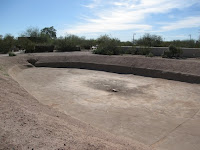 |
| Phoenix basin, view from South Mountain. |
Some 4.2 million people live in a huge sprawl of houses, six-lane streets, freeways, shopping centers, industrial sites, and office buildings variously called Phoenix, Tempe, Glendale, Peoria, Mesa, Chandler and Scottsdale. As some Tucsonans have described it to us, it's like living in L.A.
When we were migrating between Whidbey and Tucson, we either avoided Peenix or drove through and past it. I had some curiosity about the place, but Shari wouldn't let me get off the freeway. From its many freeways, there wasn't much to see that was inviting.
 |
| Park of the Canals, Mesa. |
A friend flew into Phoenix to attend a conference in Scottsdale. I drove up to bring her back home. So I can say I've also been to Scottsdale. But I don't think I really have been because Scottsdale is supposed to be impressive and I was not impressed driving its main street.
Then a few weeks back, another sister flew into Peenix to attend spring graining in Peoria. I finally got my chance to explore for a couple of days. Peenix has its attractions. The ones that interested me the most were the remaining Hohokam sites.
 |
| The platform mound at Pueblo Grande. |
In the Park of the Canals, a somewhat shabby looking place in Mesa, one can see a remnant of the Hohokam canals. When the Merkins replaced Mexicans and O'odham to settle and farm, engineers laid out irrigation lines using the ancient Hohokam canals.
 |
| The ball court at Pueblo Grande. |
The museum itself is well worth the visit. Now the area is desert scrub scattered with industrial buildings, and the nearby Phoenix Sky Harbor airport looks barren and ugly. But the museum can excite the imagination to wonder how the small Hohokam city flourished among water streams and irrigated fields.
Which is what my sister's companion remarked taking in the view of the Phoenix basin from the top of South Mountain: Imagine what this vast area looked like when water flowed and it was farmed by the Hohokam.
 |
| Typical Desert Botanical Garden sculpture (on the left). |
My sister, her friend, and I spent a wonderful couple of hours at the Desert Botanical Garden, beautifully laid out and maintained. Gourmet food in its main restaurant, an $18 admission, and a pleasant Sunday, it was crowded with better heeled sorts. The metal sculptures in the park were silly, perhaps reflecting the tastes and personal friendships of the museum's trustees. But the succulent gardens are spectacular.
There remain plenty of other sights I would like to see in Peenix, but I wouldn't want to live there.
